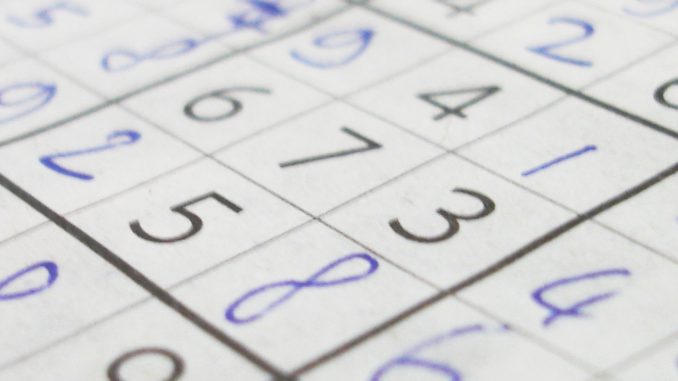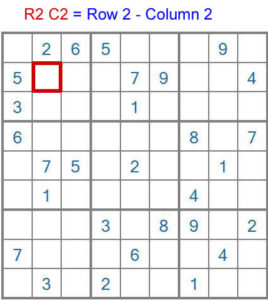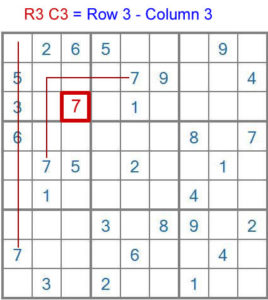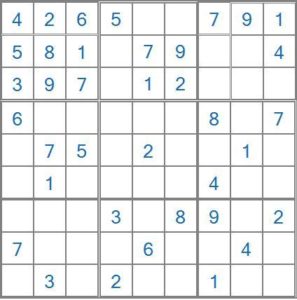
Beginner and Intermediate Strategies
Now that you’ve got some terminology under your belt, and understand the most basics element and goals of the game, let’s dig into some strategies to help you start filling in the blanks. Let’s run through a beginner level puzzle which has a unique solution, with its starting position below.

Now before you just start filling in numbers willy-nilly and hope for the best, remember that Sudoku is a game of logic. That means that there is always a way to fill in a cell’s value through a logical deduction based on the available data.
So what can we do?
Well let’s look at a few simple techniques that will help you start to fill the board up with some numbers.
Let’s start with Naked Singles
These are cells where there is only one possible number that could go into them. Why? Well as we mentioned in terminology, each cell has 20 peers, and when one of these peers has a number in it, that number cannot be used by the cell in question. In the case of naked singles, the cell has peers with 8 of the 9 numbers in them already, leaving the other number as the sole possible number, or big number, for that cell.
First take a look at R2C2, second row from the top, second column from the left. Looks like an ordinary cell right? It definitely doesn’t have a giant finger pointing to it screaming “HERE, NAKED SINGLE!”. No, it will take some detective work to unearth it, so let’s start checking the peers connected to that cell. Remember that peers are any cells in the same box, column, or row, as that cell.
We can see in the cell’s box that the numbers 2, 3, 5, and 6, are present, making them unusable by that cell. Now if we look down the column into the lower two boxes, we also see the numbers 1, 3, and 7, making them also unusable. 3 of course was already unusable, it is possible for peers to contain the same number more than once, as their circumstances are different. So we’re down to three possible candidates for R2C2, 4, 8, and 9.
As we look across the row into the rightmost boxes, we see the numbers 4, 7, and 9. The 7 is another double, but the 4 and 9 were two of our remaining three candidates. Since we can’t use them either, we now know that only the 8 can be used in cell R2C2, so we can go ahead and fill it in as a Big Number.
Next up are Hidden Singles

These are slightly different from naked singles. Check out R3C3, which contains a hidden single, the number 7.
Unlike Naked Singles, Hidden Singles don’t need to be the only candidate number in their cell, instead they must be the only cell that can contain that number out of all the cells in either that box, row, or column.
In this case look at the box that cell is in. The 7 cannot go in the cells in columns 1 and 2 because there are already 7’s in those columns in the lower boxes. And it cannot go in row 2, since there’s already a 7 in that row as well. So we know that R3C3 is the only cell that 7 can possibly go in that box. As such we can fill it in there as a big number.
So we’ve got a couple numbers filled in so far, and things are looking up, since as we fill in more numbers, it becomes more and more likely that we’ll find more naked and hidden singles and find other cells which we can use various techniques to help us figure out the big number.
There are several more naked and hidden singles available to be filled in at this point, in the following locations:
R1C7 = 7, R3C2 = 9, R1C1 = 4, R1C9 = 1, R3C6 = 2
At this point you’ll see that the upperleft most box, or box 1, only has one empty cell remaining, making it easy to find the sole number remaining by going through that box and finding the missing number. In this case that number is 1. We’ve now finished that box.
So at this point our board looks like this with the additional numbers filled in.

We’ve made some progress, but still have a ways to go. Thankfully, that’s a relatively easy puzzle, and can be solved with the use of nothing but naked and hidden singles from here on out. Go ahead and fill in the rest of it yourself if you’re so inclined.
Let’s move on to a puzzle that will force us to try out a few new techniques.
This is a more difficult puzzle that won’t be nearly as simple as the last one, check it out on the next part of this series.
Be the first to comment